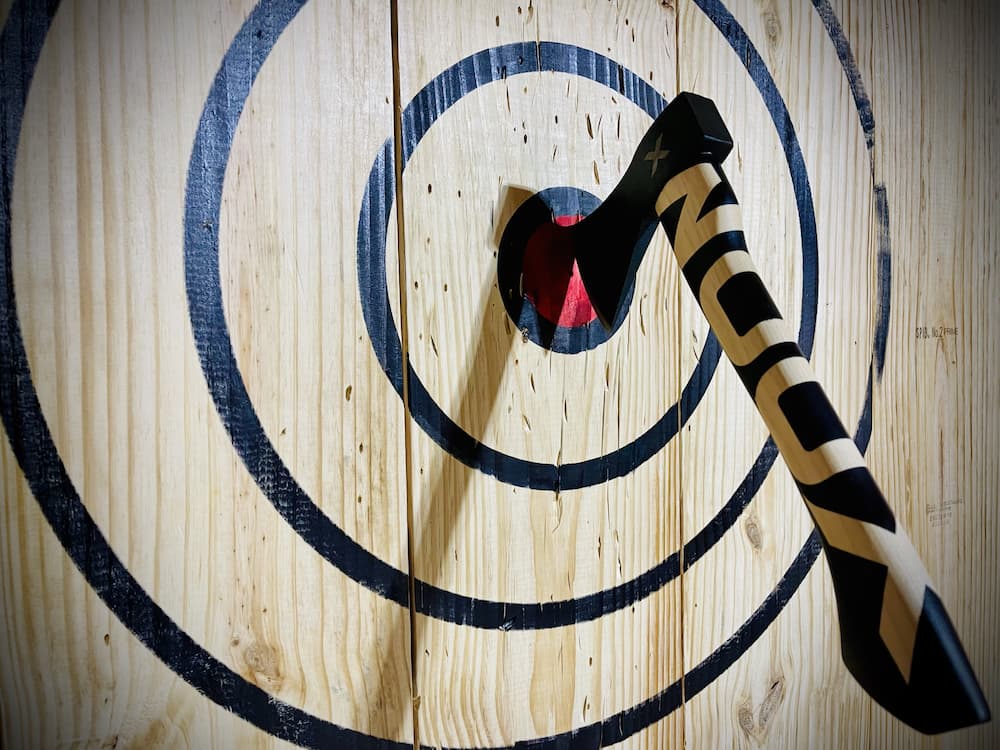Make Memories at Denver Axe Throwing: Tips for a Fun Outing
Make Memories at Denver Axe Throwing: Tips for a Fun Outing
Blog Article
The Enjoyable of Axe Throwing: Just How This Sporting Activity Integrates Ability and Adrenaline for a Blast
Axe throwing has become a captivating sport that masterfully links the need for exact skill with the rush of adrenaline, offering individuals a unique and interesting experience. The act of hurling an axe in the direction of a target demands concentration and strategy, at the same time fostering an environment of sociability and pleasant competition. This interesting blend of psychological focus and physical exertion has made axe throwing a prominent selection for those looking for both entertainment and a sense of accomplishment. To truly appreciate the depth and appeal of this task, one need to consider its origins, the required tools, and the foundational strategies that guarantee both safety and security and satisfaction.
The Origins of Axe Throwing
Axe throwing, an entertainment activity that has actually acquired considerable popularity in recent years, traces its roots back to old times. The earliest documents of axe usage in affordable contexts are found among the Celts and Vikings, who threw axes for sporting activity as well as in battle training.
Medieval European warriors, specifically during the Middle Ages, exercised axe tossing as component of their martial training. The Francisca, a sort of tossing axe utilized by the Franks, became famous for its harmful precision. This conventional weapon was developed to be tossed at opponent guards and shield, showcasing its dual energy in both sporting activity and battle.
In even more current history, axe tossing saw a resurgence in the logging camps of North America in the 19th and 20th centuries. Lumberjacks would participate in friendly competitors, checking their accuracy and strength by focusing on wood targets. This development from a survival skill to a leisure activity has actually led the way for its contemporary resurgence, with dedicated venues and organizations currently celebrating the sport worldwide.
Devices You Need
Comprehending the abundant history of axe tossing boosts the admiration of the sport's modern version. Central to this thrilling task is the devices, which is essential for both safety and security and performance. The main device is, of course, the axe. For competitive and leisure axe throwing, one of the most commonly made use of type is the hatchet, generally weighing in between 1.25 to 2 extra pounds with a manage length of about 16 inches. The axe ought to have a sharp, well-kept blade and a take care of made from long lasting wood or composite material, ensuring an excellent grasp and balance.
Equally essential is the target. Guideline targets are created from timber, with softwood ranges like yearn or cottonwood being preferred for their capability to absorb and hold the axe. The target is normally divided into 5 concentric circles, each with a particular point worth, to facilitate rating.
Security gear, however often forgotten, is important. Safety gloves can improve grasp and avoid blisters, while closed-toed footwear are a should to safeguard feet from dropped axes (ax throwing denver). A well-lit, large tossing location, complete with safety barriers, guarantees a controlled atmosphere where participants can concentrate on refining their skills.
Basic Techniques Explained
Grasping the essential techniques of axe throwing is important for both safety and security and efficiency. The leading hand must be placed directly listed below the axe head, while the non-dominant hand supports the end of the manage.
Your dominant foot ought to be somewhat onward, straightening with your target. This positioning aids in maintaining security and guiding power properly towards the target.

Security First
Ensuring safety in axe throwing is extremely important to producing an injury-free and enjoyable experience. Precaution begin with the location layout. A well-designed axe tossing center features clear demarcations between throwing lanes, strong backgrounds to capture stray axes, and non-slip flooring to avoid accidents. Additionally, adequate illumination is important to help participants maintain visual precision and spatial recognition.
Benefits of Axe Throwing
Axe tossing offers a myriad of benefits that expand beyond basic leisure. Physically, it provides a full-body workout, engaging muscles in the click resources arms, shoulders, back, and core. The recurring movement of throwing the axe likewise enhances hand-eye coordination and fine motor abilities. For those looking to improve their overall health and fitness, axe throwing can function as a interesting and vibrant type of exercise.
Psychologically, axe throwing needs precision, focus, and technique, making it an exceptional means to develop cognitive skills. The focus required to hit the target can function as a kind of mindfulness, allowing individuals to clear their minds and decrease anxiety. This mental engagement can be especially beneficial in aiding individuals develop much better analytical skills and psychological resilience.
Socially, axe throwing is frequently appreciated in group setups, cultivating team-building and friendship. Whether as part of a business event or a casual trip with buddies, the sport encourages interaction and collaboration. In addition, the public experience of discovering and improving with each other can reinforce connections and develop enduring memories.
Final Thought

The earliest records of axe use in affordable contexts are located among the Celts and Vikings, who tossed axes for sporting activity as well as in combat training. Launch the axe when your hands are approximately at eye level, enabling the axe's natural rotation to assist it in the direction of the target.
A well-designed axe tossing facility features clear demarcations between throwing lanes, sturdy backdrops to catch roaming axes, and non-slip floor covering to protect against accidents. Participants need to be instructed on the proper means here to throw the axe and deal with, highlighting managed, calculated motions over powerful throws.
In summary, axe throwing stands out as a sporting activity that masterfully incorporates accuracy, ability, and adrenaline.
Report this page